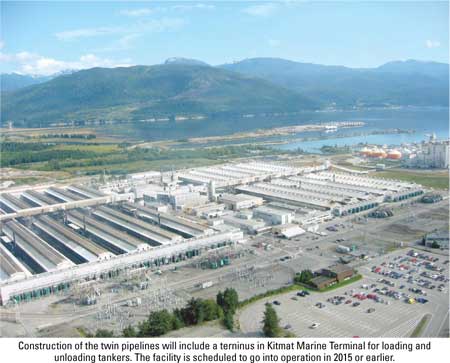
Canada: tomorrow’s energy superpower
By Leo Quigley, AJOT
During his inaugural trip to Asia in early December Canada’s Prime Minister, Stephen Harper, told a business audience in Shanghai that Canada is an emerging energy superpower. Canada, he said, can provide the stable sources of energy China will need for future growth and he drove home the point by saying Canada is seventh in the world in crude oil production – with the second largest proven reserves – third in natural gas production and the world’s largest producer of uranium.
Oil
At present crude oil flows through the Port of Metro Vancouver via a Kinder Morgan Canada pipeline at 300,000 bbl/d (barrels of oil per day). The company has said it has plans to expand that to 700,000 bbl/d and to market a portion of that to Asia. However, a second West Coast pipeline is also in the planning stages. Canadian-owned Enbridge Inc. is expected to file a regulatory application early this year for construction of its 1,170-kilometre Northern Gateway Pipelines between Edmonton and the Port of Kitimat to move bitumen from the Alberta Oilsands to the Pacific Rim. Construction of the twin C$4.5 billion, 525,000 bbl/d, pipelines will include a terminus in Kitimat for loading and unloading tankers. The facility is scheduled to go into operation in 2015 or earlier,
LNG
Apache Canada Ltd. and Kitimat LNG Inc. are planning to break ground this year on a C$3 billion plant that, in partnership with Pacific Northern Gas, will move 700 million cubic feet of natural gas per day, most of it destined to a liquefaction and marine export terminal to be located roughly 15 kilometres from the Port of Kitimat. The purchase of a majority share of Kitimat LNG by Calgary-based Apache was announced in mid-January of this year. The terminal will export LNG to the Pacific Rim and is scheduled to begin operation in 2013 or earlier. Last year Mitsubishi Corporation agreed to purchase 1.5 million tons of LNG per annum from the plant and acquired an equity stake in the project. As well, Korea Gas Corp. and the co-operative Gas Natural Utility, based in Barcelona, Spain, have already agreed to buy LNG from the plant.
As well, Vancouver based Teekay Corp has agreed with Merrill Lynch Commodities Inc. to convert a liquefied natural gas tanker into a floating production unit at the Port of Kitimat. Teekay plans to modify the Arctic Spirit, an 88,200 cubic meter LNG transport, into a floating production plant that will produce 0.5 million tons a year of LNG for export beginning in 2012. The Arctic Spirit is one of two LNG carriers witha self-supporting prismatic type B cargo containment system and Teekay believes it is well suited to the task.



Follow us on social media: